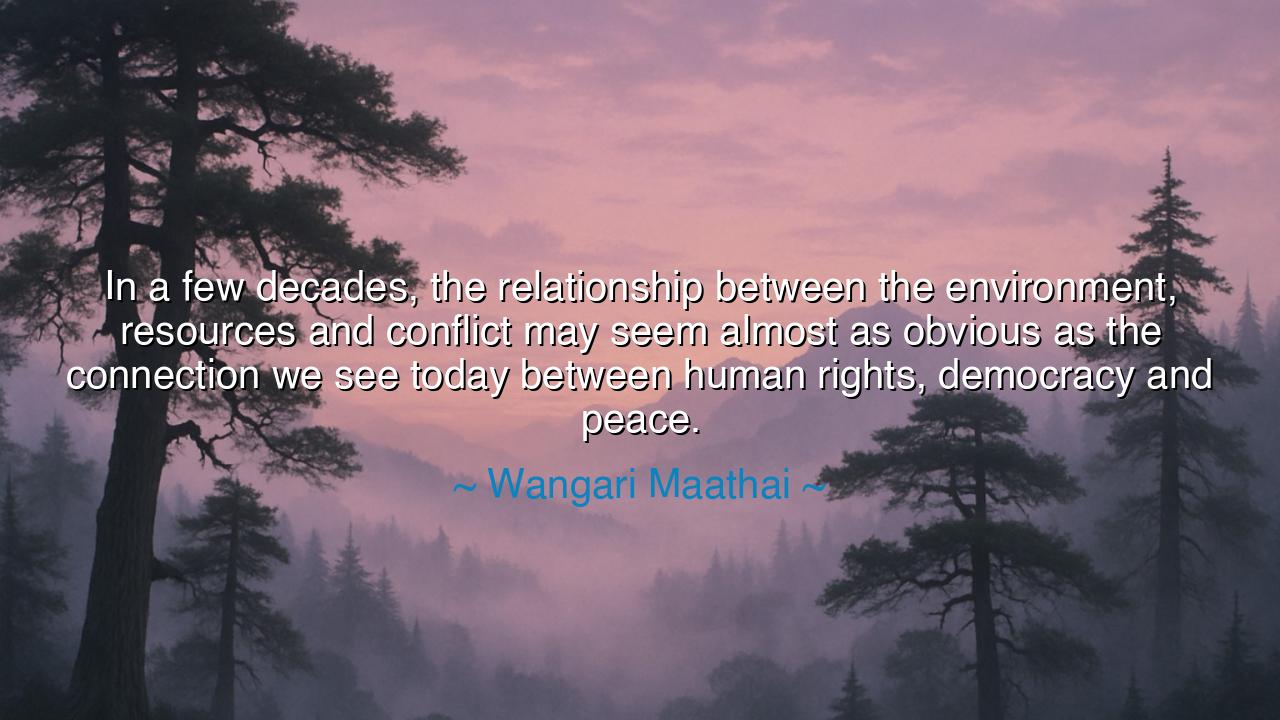
In a few decades, the relationship between the environment
In a few decades, the relationship between the environment, resources and conflict may seem almost as obvious as the connection we see today between human rights, democracy and peace.






When Wangari Maathai declared, “In a few decades, the relationship between the environment, resources and conflict may seem almost as obvious as the connection we see today between human rights, democracy and peace,” she spoke not as a mere observer of nature, but as a prophet of the Earth’s destiny. Her words were forged from experience, from years of witnessing the wounds of deforestation, drought, and division. In her wisdom, she foresaw a truth that the modern world often ignores: that the environment is not separate from human affairs — it is the silent foundation upon which peace, justice, and prosperity stand. When the land dies, the people follow; when the water dries, conflict rises.
In ancient times, great civilizations were built upon rivers — the Nile, the Tigris, the Indus, the Yellow River. These waters nourished life and sustained empires. But when those rivers were misused or exhausted, kingdoms fell to dust. The balance between humanity and the environment has always been a sacred covenant, though many have forgotten it. Maathai’s words remind us that wars are not only fought with swords and guns; they are also fought in the silent struggle for fertile land, clean air, and flowing rivers. When resources vanish, desperation grows. And where desperation grows, conflict blooms like a poisonous flower.
Consider the story of Darfur, a region once rich with grazing lands. As the rains grew scarce and the soil turned to dust, herders and farmers were forced into competition for survival. What began as an environmental crisis soon became a human one — ethnic divisions inflamed, violence erupted, and countless lives were lost. It was not hatred alone that fueled the war, but scarcity — the slow death of the Earth’s abundance. Maathai saw this pattern across nations: how the degradation of resources leads to the degradation of peace. The Earth, when mistreated, becomes not a mother, but a battlefield.
Wangari Maathai herself lived this truth. In Kenya, she founded the Green Belt Movement, where women planted trees to restore the land and, through that act, restored dignity. What seemed like a simple gesture — planting a tree — became a rebellion against both environmental destruction and political corruption. Her hands worked the soil, but her heart worked for peace. In every seed she placed, she sowed hope. And in time, she taught the world that sustainability and stability are intertwined, that peace cannot take root where the Earth is barren.
The ancients would have understood her message well. For they, too, saw the Earth as sacred — a mother spirit to be revered, not exploited. To harm her was to invite famine and curse. Yet, modern humanity, in its hunger for profit, has forgotten this divine order. We rip forests from the soil and call it progress; we poison rivers and call it convenience. Maathai’s vision warns us that this blindness will not go unpunished. For nature is patient but not forgiving. One day, she will answer — and her response will echo in floods, storms, and fires.
Still, Maathai’s tone was not of despair, but of awakening. She believed that humanity could yet evolve — that one day, environmental protection would be seen as inseparable from peace and justice. Just as the world learned that oppression destroys both the oppressed and the oppressor, so too will it learn that environmental neglect destroys both the rich and the poor, the powerful and the weak. The harmony between people and planet is not idealism; it is survival.
The lesson, then, is clear and eternal: There can be no peace without respect for the Earth. Every tree saved, every river cleaned, every resource shared wisely is a step toward a more stable and compassionate world. If nations invested in restoration rather than exploitation, they would sow unity rather than war. And if individuals cherished the Earth as kin, they would live in abundance, not in fear. The soil beneath our feet is not mere dirt — it is the bridge between peace and conflict, between prosperity and ruin.
So let Maathai’s words be carried as a torch through the generations. Teach your children that to defend the environment is to defend the human spirit. For as surely as the dawn follows the night, one day all will see what she saw: that the bond between the environment, resources, and peace is as unbreakable as the bond between human rights, democracy, and freedom. And those who nurture the Earth will be remembered as the true keepers of peace — the guardians of life’s sacred harmony.






AAdministratorAdministrator
Welcome, honored guests. Please leave a comment, we will respond soon